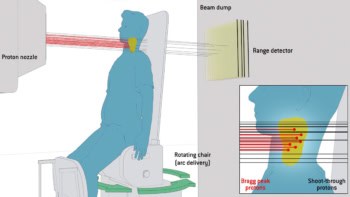
Proton therapy is an advanced cancer treatment technique that offers a significant advantage over conventional photon-based radiotherapy: protons have a finite range at which they deposit the majority of their dose, thus sparing healthy tissues located near the tumour. Accurate targeting, however, is essential to fully exploit the dose conformality of proton beams. And currently, there’s no imaging technique available that can provide real-time beam range monitoring for routine clinical use during proton therapy.
As a result, proton treatments employ safety margins around the tumour to account for uncertainties caused by morphological changes along the beam path and to ensure adequate target coverage. Unfortunately, such margins (commonly 2.5–3.5% of the nominal range plus 1–3 mm) compromise the potentially high dose conformality.
One approach proposed to address this dilemma and improve targeting accuracy in treatments of moving tumours is the use of MRI guidance – as implemented for photons with hybrid MR-linac technology. With this aim, a research team at OncoRay and HZDR has successfully integrated a low-field open MR scanner into a proton research beam line.
Aswin Hoffmann and his team have now used this research system to demonstrate that online MRI can visualize the proton beam and reveal its range during irradiation of liquid-filled phantoms. They report their findings in Proceedings of the National Academy of Sciences.
Seeing the beam
The set-up at OncoRay comprises an open 0.22 T MR scanner, radio-frequency-shielded by a Faraday cage and installed in the path of a horizontal proton research beam line. For this latest study, the researchers placed a 10 × 10 × 6.5 cm polyethylene box filled with tap water centrally in the MRI receiver coil. They then irradiated the phantom using proton beam energies of 200, 207 and 215 MeV (at a beam current of 32 nA) and currents of 8, 16, 32 and 64 nA (at 207 MeV).
During each irradiation, the researchers performed time-of-flight angiography MRI, acquiring images for 5 s, starting 15 s after the start of irradiation. They observed energy- and current-dependent proton beam signatures that resembled the shape of the dose distribution measured using radiochromic film.
With increasing beam energy, the range (seen as a hypointense signal on the MR image) was increasingly displaced along the beam direction. The measured range shifts relative to the 200 MeV beam – 1.6 and 3.4 cm, for 207 and 215 MeV beam energies, respectively – agreed with calculated range values to within 2 mm. The intensity of the signature decreased with decreasing beam current and faded out below 8 nA.
The researchers note that the MRI contrast mechanism underlying these observations is not yet fully understood. However, they suggest that as similar signatures are found in other liquids, but not in flow-restricted water phantoms or gels, the effect may be due to convection arising from radiation-induced local heating and thermal expansion of the water.
QA and beyond
The imaging technique could find immediate application for geometric quality assurance in MR-integrated proton therapy systems currently under development. Further ahead, it may be possible to use MRI to provide real-time feedback on the beam range and energy deposition during proton therapy, although the method has so far only proven feasible in liquids and is likely not transferable to patients in its current form.

One step closer to real-time MR imaging in proton therapy
“Therefore, our research group is continuing to unravel the underlying MRI contrast mechanisms behind these observations, in order to ideally design a novel MRI sequence that would allow MRI-based in vivo proton range verification,” explains first author Sebastian Gantz. Such a scheme could provide an alternative to proton range monitoring approaches based on ionoacoustics or detection of secondary radiation.
“While both ionoacoustics and prompt gamma detection are indirect methods capable of detecting the proton beam end-of-range, the appeal of the MRI-based method is that we are able to visualize the proton beam in 2D,” Gantz tells Physics World. “Potentially, in the future, we can use one imaging modality, in-beam MRI, to concurrently visualize both the beam and the patient anatomy.”



